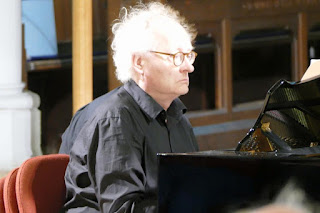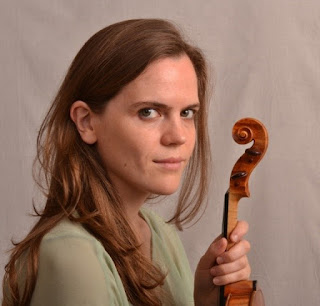 |
| Alasdair Beatson & Olga Jegunova © Rob Read, LCMF |
Alasdair Beatson (piano)
Olga Jegunova (piano)
Bengt Forsberg (piano)
Alina Ibragimova (violin)
James Boyd (viola)
Jonathan Cohen (cello)
Schubert: Variations for four hands in A flat major, D813
Fauré: Barcarolle No.
10, Op. 104. No. 2
Nocturne
No. 7, Op. 74
Beethoven: Serenade for String Trio in D major, Op. 8
String Trio in E flat major, Op. 3
Saturday 18 June 2016
★★★★★
The Lewes Chamber Music Festival, now in its fifth year, is
going from strength to strength, and this year’s programme included a great
variety of repertoire from an impressive roster of talented performers. You can read more about the festival and this
year’s programme here. I would happily
have attended all eight concerts given time – and from conversations overheard
in the audience, I suspect some did.
However, I picked to attend concert number four, with music for piano four
hands by Schubert, followed by String Trios by Beethoven – with some extra
Fauré piano music thrown in (more of that later).
Schubert’s Variations for four hands in A flat major, D813,
were composed in 1824, and Schubert specifically mentions them in a letter to
his brother at the time as an example of his new found sense of ‘happiness and
peace’. They are a perfect example of
Schubert’s ability to take a relatively straightforward melody (although here
he does include an unexpected modulation to C minor in its second half), and
transform it through repeated reinvention into something deeply profound. Here, it is in the penultimate seventh
variation that this high point of profundity is reached, when the rhythmic pace
is suddenly slowed and the primo player (Alasdair Beatson) plays almost a
recitative over the unexpected harmonies and unresolved suspensions of the
secondo part (Olga Jegunova). That C
minor shift at the end of the first half of the theme is now transformed into a
passionate blossoming in C major, setting up a new spirit for the final
extended variation, with an energetically rousing finish. Leading up to this, however, the first six
variations build through Schubert’s highly varied use of textures, with
delicate triplet decoration in the first, and a particularly expressive slow, funereal
march (more than reminiscent of the second movement of Beethoven’s Symphony No.
7). Throughout, Beatson’s and Jegunova’s
blend and close communication were evident, and where Schubert passes melodies
and runs from player to player, this felt seamless and effortless in their
hands. The seventh variation had a
particularly passionate intensity, and they finished off an excellent
performance with a brilliantly spirited final variation.
 |
| Bengt Forsberg © Rob Read, LCMF |
Then to end the first half of the concert, there was an
addition to the programme. Pianist Bengt
Forsberg, who had already appeared in two of the Festival’s concerts, and would
be returning for two more the next day, gave us some beautifully sensitive
Fauré. First he played the darkly
rocking Barcarolle No. 10, Op. 104 No. 2, with its chromatic, fluid harmonies, and he followed
this with the substantial Nocturne No. 7, Op. 74, the longest of Fauré’s
thirteen Nocturnes. This begins with a relatively straightforward falling line,
but Fauré takes this into ever increasingly chromatic and complex harmonic
realms, with a highly contrasting central section. This becomes more and more decorated, with
rippling textures and rapid flourishes, before the opening material returns
briefly, followed by a short, quiet coda.
Forsberg played with great subtlety and sophistication, with an
intensity that Fauré’s opaque piano music demands. This provided a wonderful contrast to the
sublime Schubert that preceded it, bringing the first half of the concert to a satisfying
close.
 |
| Alina Ibramigova, James Boyd & Jonathan Cohen © Rob Read, LCMF |
Following the interval, another change of personnel, and we
were now in early Beethoven territory – his two early examples of works for
String Trio. Aside from the String Trio
in E flat major, Op. 3 and the Serenade for String Trio in D major, Op. 8,
Beethoven wrote three more as a set, Op. 9, before turning his attentions to
the string quartet. Both of the early works, which we heard tonight, follow the
model of Mozart’s only work for string trio, the Divertimento K563, and consist
of six movements each, both with two Minuet & Trio movements framing a
central Adagio movement. Around this he
begins and ends the works with faster movements, and an additional slower
second movement. The two early works are
not insubstantial, running at over an hour combined – and this leads to my one
criticism of the evening’s programme.
Both works might have benefited from separation from each other, as
hearing them together did perhaps emphasise their similarities of form. However, they are certainly not without
moments of great interest and glimpses of Beethoven’s ability to subvert the
conventions of form, and Alina Ibragimova (violin), James Boyd (viola) and
Jonathan Cohen (cello) gave highly engaging and communicative performances that
highlighted moments of humour and surprise within Beethoven’s music. They played the Op. 8 Serenade first, and
immediately we had a sense of energy from the players in their attack in the
opening March. The Adagio that follows has a feel of a musette, with the double-stopped
cello grounding the texture. Throughout
their performances, there was a strong sense of communication and they blended
their warm tones in the rich, thick textures of this movement in particular. The church perhaps has a rather boomy acoustic
that at times hampered articulation, although this improved with time as they
settled in. The first of the minuets had
great rustic humour, and the second had a dancing lift to the rhythms. Between them, Ibragimova and Boyd sang the
sad melody of the Adagio in unison with perfect blend – and they all enjoyed
the quirky central section here. Beethoven ends the work with a Theme and
Variations, and here each player gets more of a solo chance to shine, with
delicate decoration from the violin then viola in turn, and later a cantabile
solo cello line in the fourth variation.
The movement comes to a quiet conclusion before Beethoven brings back
the opening March to close the work.
The String Trio, Op. 3 contains throughout lots of Beethovenian
use of stops and starts, unexpected rests and false endings, and once again the
players had fun with the element of surprise, much to the audience’s delight. The lengthy sonata form opening movement was
given a warm rendition, and the blend within the full acoustic was noticeably
more settled here. The second movement
kicks off with offbeat rhythms, and it takes the listener a little while to
settle into the pulse, one of Beethoven’s favourite tricks. Ibragimova played
with great delicacy here, and the exchanges of trills between viola and cello
were also handled with precision and subtlety. More stop/start rhythms in the
first Minuet, and once again communication between players was paramount to
place these moments together. Beethoven
pares things down for the Adagio, with a singing violin line, lilting viola
accompaniment and simple cello bass line.
When the material returns at the end of the movement, there was some incredibly
touching and sensitive pianissimo playing here.
In the finale, Beethoven writes his most virtuosic music for the
players, and they all get more of a chance for individual display. There is some rapid figuration, and
Ibramigova and Boyd demonstrated tight ensemble in their joint runs. The dash to the finish line had great energy
– no mean feat at the end of two highly committed and demanding
performances.
Overall, this was an impressive evening of the highest
standard of chamber music playing, in a warm and friendly atmosphere. I trust this was typical of the rest of the
festival, and I for one will be returning next year, and hopefully with time to
sample more of the delights on offer.



